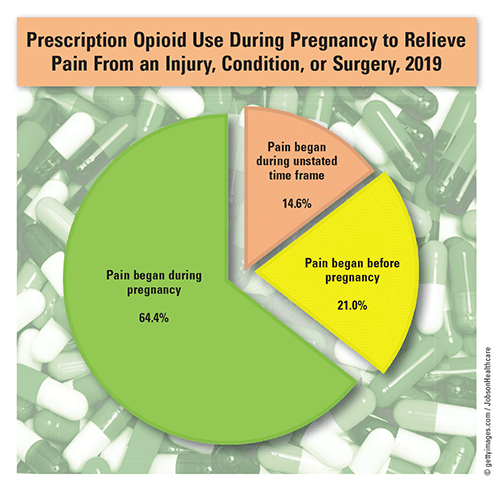US Pharm. 2021;46(3):14.
According to a CDC report for 2019, although the overall prevalence of prescription opioid use during pregnancy was 6.6%, patients younger than age 19 years were the most frequent users of these pain relievers (prevalence rate, 9.6%). The rate of opioid use decreased from 7.5% to 6.5% to 5.5% among pregnant patients aged 20 to 24 years, 25 to 34 years, and 35 years and older, respectively. Approximately 68% of pregnant patients taking prescription opioids received counseling from a healthcare provider (HCP) regarding adverse effects of opioid use on the baby, and although HCPs counseled 69.0% to 71.1% of pregnant patients older than age 25 years, a lesser proportion of patients younger than age 25 years received such counseling.

Risk Factors: Educational level appeared to have a relation to opioid use during pregnancy. Pregnant patients with some college education (6.1%) were least likely to use opioids, followed by those who completed or did not complete high school (7.1% and 8.4%, respectively). Prescription-opioid use did not differ between patients who initiated prenatal care during the first or second trimester (6.2% vs. 6.3, respectively). In patients who had behavioral risk factors such as depression (rate of 13.1%) and smoking (rate of 16.2%), the use of prescription opioids during the last 3 months of pregnancy was disproportionately higher than in those who were not depressed (142.6% higher) and did not smoke (174.6% higher).
Sources of Prescription Opioids: Although HCPs constituted the vast majority (91.3%) of the sources of prescription opioids used during pregnancy, other sources also played a role, including family/friends (1.9%) and leftover pain relievers from an old prescription (5.4%). HCPs who prescribed opioids for use during pregnancy included obstetrician-gynecologists (55.4%), emergency-department physicians (26.0%), primary care physicians (14.9%), and oral-care providers (12.8%).
Reasons for Use During Pregnancy: Use of prescription opioids to relieve pain from an injury, condition, or surgery was most common in patients whose pain began during pregnancy, followed by those whose pain began before pregnancy or during an unstated time frame. The rate of misuse of opioids during pregnancy was 21.2%. Reasons for misuse included help with sleep (7.9%), relaxation or relief of stress (7.7%), help with negative feelings (3.7%), and “being hooked/having to use” (2.4%). About 27% of these patients said that they wanted to stop misusing prescription opioids.
The content contained in this article is for informational purposes only. The content is not intended to be a substitute for professional advice. Reliance on any information provided in this article is solely at your own risk.
To comment on this article, contact rdavidson@uspharmacist.com.





